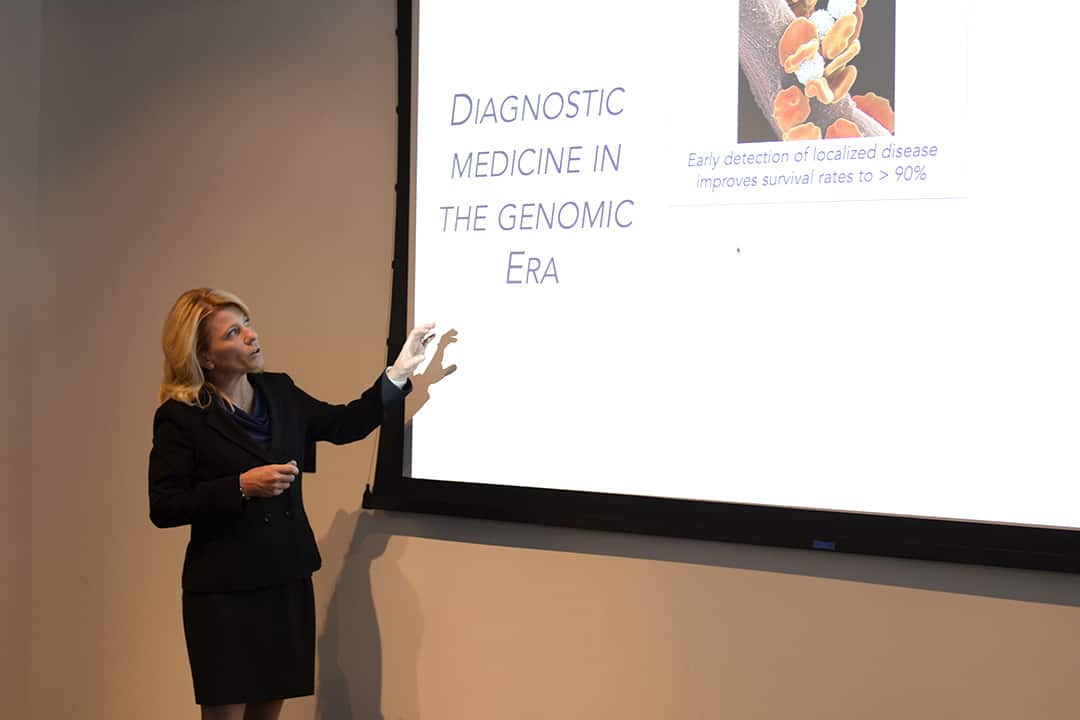U of T professor, scientist, and entrepreneur Shana Kelley shared her experiences in launching three medical diagnostics startups during her Entrepreneurship Week talk “From concept to acquisition and back again.”
Kelley, who is cross-appointed to several departments including Biochemistry and Pharmaceutical Sciences, presented two guiding principles for starting a successful life science startup.
The first is to let your initial ideas in research and business interact to form new ideas for opportunities. She quoted John Steinbeck, who wrote, “ideas are like rabbits. You get a couple and learn how to handle them, and pretty soon you have a dozen.”
The second guiding principle is to accept that you don’t need to figure out all aspects of running a startup company before its launch. “You’ve got to jump off the cliff, and then you’ve got to work like heck to build your wings before you get to the ground,” Kelley said, quoting Ray Bradbury.
She noted that even if you think you have your startup figured out, conditions and assumptions often change over the course of its development.
Preparation, perseverance, and patience
Kelley advised perseverance and patience during the initial stages of launch, reflecting on how she received 83 rejections by investors for her startup Xagenic.
“You have to go through that process,” she said. “You have to get the answer that’s no, and reflect a little bit on why they said no; maybe adjust your strategy going forward and then just keep going and keep going and keep going.”
Furthermore, while there is space to learn on the job, Kelley noted that startup ideas should be based on research that is reproducible, robust, and that essentially “works every time.”
“Do that before you even near the idea of starting a company,” she said. She advised against trying to figure out the fundamental science at a later stage when “venture capital investors [are] kind of breathing down your neck.” She also suggested ensuring that the discovery is patentable, so it can serve as an asset around which to base the company.
Kelley further recommended that entrepreneurs start companies staffed by people with whom they already work well. A clear business plan and potential applications of the technology to better secure funding are also essential. Part of the initial research involves speaking with potential clients of the technology, such as clinicians or patients for many products in the life sciences.
Kelley’s concept to acquisition and back
Kelley launched her first startup in the late 1990s as a PhD student at the California Institute of Technology. Studying the electrical conductivity of human DNA molecules, she found that double-stranded DNA is normally a semiconductor. However, minor mutations in these strands could stop a DNA molecule from conducting electricity.
Without a clear idea of how to turn the discovery into a marketable technology, Kelley and her graduate advisor filed a patent and went to the institute’s technology transfer office. It was the time of the dot-com bubble, which meant the office was easily able to find them an investor who offered $5 million in funding to develop an application for the discovery.
Kelley and her advisor used the funding to start a company named GeneOhm Sciences, which used Kelley’s discovery to create a diagnostic test for antibiotic-resistant MRSA bacteria. These ‘superbugs,’ which can be deadly to patients with compromised immune systems, are easily introduced into hospitals by visitors who unknowingly carry the pathogen. The firm developed a convenient test for visitors that used a nasal sample, and it was later acquired by the diagnostics company Becton, Dickinson and Company in 2006.
Kelley’s next startup was Xagenic. She co-founded the firm around 2009 with the goal of developing a faster, more convenient test for doctors to diagnose sexually transmitted infections (STIs) in patients. She noted that the idea was promising, as clinicians had wanted to perform on-the-spot STI testing to better limit the spread of infections.
STI testing is also around a billion-dollar market, noted Kelley, with a straightforward regulatory path to developing the product. The firm benefitted from developing a product for an existing high-value market with little regulatory risk, and with an existing demand among clinicians. This made Xagenic attractive to investors, who are often skeptical of startups that develop products without existing demand. The firm was ultimately acquired by defence contractor General Atomics in 2018.
The final startup Kelley mentioned is Cellular Analytics, which she recently incorporated as a partnership between U of T and the Ontario Institute for Cancer Research. The firm plans to develop microfluidic technology to analyze tumour cells from blood samples of patients with cancer, which may be less invasive than analyzing cells from tissue samples.


